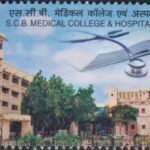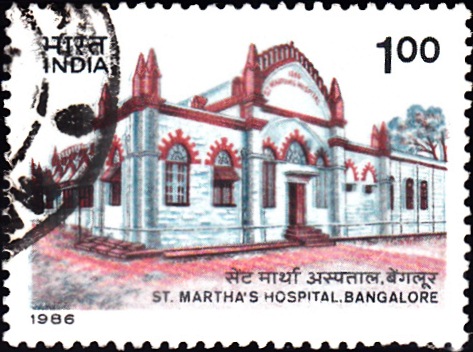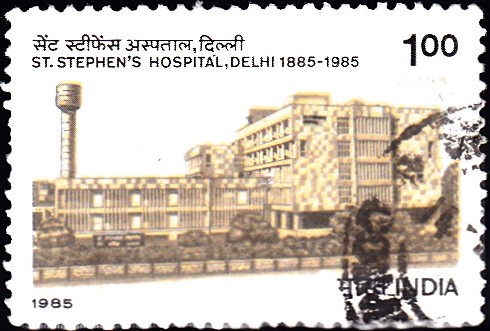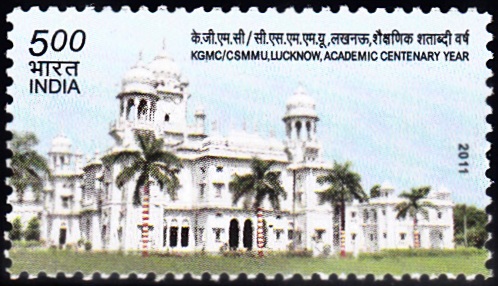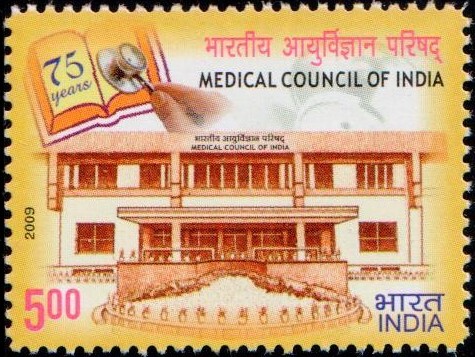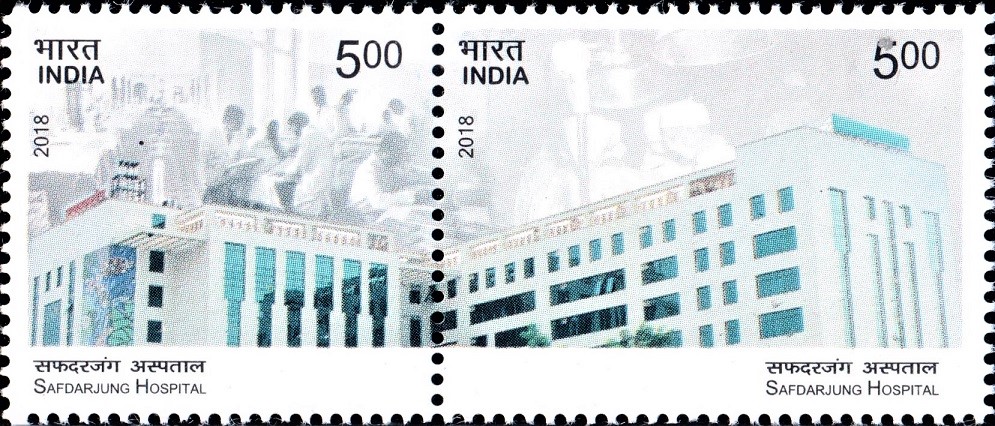
Safdarjung Hospital
Complete set of 2 commemorative postage stamps on the 80th Anniversary of SJ multi-specialty Hospital in New Delhi, largest Central Government hospital (by bed strength) in India :


 Issued by India
Issued by India
Issued on Apr 27, 2018
Issued for : Department of Posts is pleased to issue a se-tenant Commemorative Postage Stamps on Safdarjung Hospital.
Credits :
Stamp/FDC/Brochure : Designed by Sh. Anuj based on the photographs received from US Army Signal Corps, National Archives and Records Administration, United States and Ashoo Sharma
Cancellation Cachet : Smt. Nenu Gupta
Type : Se–tenant pair of 2 Stamps, Mint Condition
Colour : Multi Colour
Denomination : 500 & 500 Paise
Stamps Printed : 603500 each
Printing Process : Wet Offset
Printer : Security Printing Press, Hyderabad
About :
- A major flagship hospital of the Government of India, Safdarjung Hospital is spread over a land area of 47 acres in the heart of Delhi. Citizens from different parts of the country, and many neighbouring countries, visit the facility to receive life-saving treatment. On most days, the hospital attends to around 1,400 emergencies, 8,000-9,000 out patients, and its three dozen wards play home to 2,500 to 3,500 patients. In its two labour rooms, more than 75 babies are born each day, while its 40 operation theatres hum 24×7 with surgeons operating on patients to offer them a new lease of life.
- The origin of this hospital can be traced back to year 1942. Dark clouds, billowing with smoke of World War II, were hanging heavy over the China-Burma-India war theatre. With the casualties mounting, the injured US soldiers needed immediate treatment. US Army Commander General Joseph Stillwell took an active decision to build the 100th Station Hospital in Delhi. Soon a new hospital, popularly called the American Hospital, took shape in the newly erected army barracks. Strategically built close to the city’s lone airstrip, the Willingdon Airfield, the hospital commenced operations with 150 beds, an X-ray machine and operation theatres. US Army Medical Corps nurses and doctors worked round the clock in the hospital to salvage brave lives.
- The War ended, and soon, India became independent, a master of her own destiny. The Government of India decided to dedicate the wartime American hospital to her people. With its portals thrown open to the public, the hospital began operations with 204 beds and was rechristened as Safdarjung, after the Raja of Awadh Mogul General Abul Mansur Mirza Muhammad Muqim Ali Khan.
- In time, as the hospital grew brick by brick, inch-by-inch, new buildings were added, new departments came into being, and the facility grew with each passing year. While still in its early formative years, it became a temple of faith and hope for the sick. People came from far for treatment and healing.
- Since the 1950s, the hospital has been country’s major academic hub. Its clinical wards and laboratories have honed thousands of paramedics, nurses and MBBS, MD/MS and postdoctoral students. If in 1950s, its wards were the clinical training ground for the first few batches of students from the All India Institute of Medical Sciences; between 1972 and 1989, it was alma mater to the students of University College of Medical Sciences. Since 2002, the hospital has been a home for the students of Vardhman Mahavir Medical College. Over the years, many alumni of the hospital have found huge acclaim, and hold chairs of eminence globally.
- Down the ages, the faculty of the hospital has made a legendary contribution in the realm of academics, clinical research and patient care. In the 1960s, paediatrician Dr Shanti Ghosh flagged the mission of building neonatal nurseries in public hospitals, and is fondly remembered to this day as the mother of Neonatal Medicine in India. Orthopaedic surgeon Balu Sankaran founded the Artificial Limb Manufacturing Corporation of India in 1972 to aid the rehabilitation of soldiers injured during the Bangladesh war. Two years later, he set up the first rural rehabilitation training centre – the Swami Vivekanand National Institute of Rehabilitation Training and Research in Olatpur, Odisha. Anatomist Dr Ramji Das’s seminal work in neuro anatomy formed a part of the bible of the days, Gray’s Anatomy, while Sankaran’s surgical techniques waxed proud in Campbell’s Operative Orthopedics. Physiologist Dr Ramesh Bijlani carried out seminal research on the positive role of yoga in prevention and management of coronary heart disease.
- In 1982, plastic and micro vascular surgeon Dr. S. P. Balaji established the first micro vascular surgery centre in North India on his return from UK. Deeply devoted, he was soon to become a legend for his marathon single-handed 15- to 20-hour long surgeries. He developed many new surgical techniques, and rejoining severed limbs he performed Delhi’s first wrist, arm and leg replants. In 2000, he also established the first skin cell culture lab in Delhi. The early 1980s also saw a number of other pioneering developments: ENT surgeon PS Saharia devised a new septorhinoplasty technique for a twisted nasal partition; while Dr JC Suri established the country’s first public sleep lab and pulmonary critical care unit. Later, just before the Commonwealth Games 2010, the hospital acquired North India’s first Sports Injury Centre.
- Holding the flag of being the country’s largest public hospital, Safdarjung is all set to take wings to emerge as one of the finest world-class healthcare facility. The mission is noble and pious as the institution stands deeply committed to deliver affordable state-of-art healthcare to the people in a caring, friendly environment.
- Text : Based on the information received from proponent.


